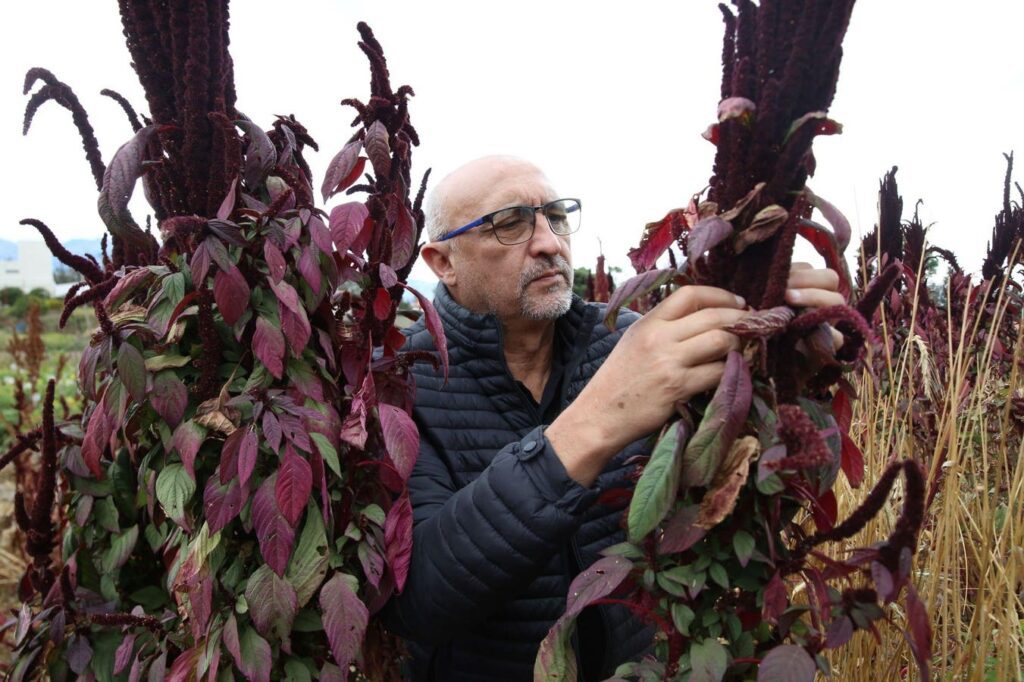Cesar Tapia in the field at a Universidad Técnica del Norte experimental station in August 2024.
Luis Salazar/Crop Trust
In Ecuador, researchers are conserving the genetic legacy of cocoa (Theobroma cacao), the raw material of chocolate.
Cocoa (or cacao) is derived from the fermented and dried seeds of the Theobroma cacao tree and though the largest production areas are now in Africa, wild relatives and ancestral varieties abound in Colombia, Peru and Ecuador. It is also one Ecuador’s key crops, with production growing at an average annual rate of 15 percent since 2014.
Cesar Guillermo Tapia Bastidas, head of Ecuador’s national department of phytogenetic resources at the country’s National Institute of Agricultural Research, explains that their germplasm bank consists of approximately 28,000 accessions that are conserved in the field, in vitro, cryopreservation and cold storage.
“The cocoa collection, which consists of approximately 2000 accessions that are conserved in the field at the Pichilingue Experimental Station, Litoral Sur Experimental Station and Central Amazonian Experimental Station, began in the 1950s as an inter-institutional initiative with colleagues from the United States, and grew over time with the support of various donors and the Ecuadorian government,” he says.
Small producers in Ecuador continue to face challenges of improving production and finding sustainable supply chains, but the genebank is key in preserving Ecuador’s highly regarded varieties.
“This collection is one of the largest in Latin America with very important materials such as fine aroma cacao,” he says.
Tapia explains that the motivation for starting the germplasm bank is that underutilized crops, such as grains, tubers and high Andean roots, were being lost in the 1980s.
“The bank conserves native and exotic agrobiodiversity of grains, tubers and high Andean roots, Amazonian and tropical fruit trees, forest species, medicinal plants and export crops such as cocoa, coffee, bananas, African palm, achiote, among others,” he says.
Tapia explains that the gene bank is a source of genes for breeding programs and for obtaining improved varieties with high productivity, resistant to pests and diseases and with important nutritional quality, while also helping to return these preserved varieties to agricultural communities, to encourage biodiversity, support agro-tourism and develop value-added products.
“In a nutshell, genetic resources for food and agriculture are what is feeding the world but unfortunately there is still a lack of awareness and knowledge to use and conserve them,” he says, “I think the biggest challenge is to avoid the genetic erosion that these genetic resources suffer and the next step in the near future will be to develop the red book of native agrobiodiversity of Ecuador that will allow us to alert about the loss of this important diversity that has been domesticated by our people for more than 10,000 years.”
ECUDORIAN CACAO
getty
Growing Up in Ecuador
Tapia is from Ecuador’s Pichincha province and growing up was passionate about nature and the mountains.
“Working with this biodiversity made me realize where to go professionally and my love for the agrobiodiversity of my country began to grow, taking into account that I am in a mega-biodiverse country,” he says, “Almost immediately that I became involved in the life of indigenous and farming communities and their biodiverse production systems, I began to observe a significant loss of native varieties of species of importance for food security.
Tapia explains that this was approximately 30 years ago, when crops such as quinoa, amaranth, melloco, mashua, oca were still considered weeds instead of the superfoods they are known as today.
“I graduated from the University with a degree in Agricultural Engineering, I did my thesis on minor Andean tubers (melloco, oca, mashua) at INIAP where I continue to work until today,” he says. “Today we have a germplasm bank that is the largest in the country, conserving agrobiodiversity of many crops of importance for food security, for export and with very important nutritional characteristics.”
Tapia explains that researchers from the Global South play a fundamental role in the generation of technology that contributes to the solution of global problems.
“It is also important that researchers participate in politics mainly in the generation of laws,” he says, adding that he also participated in the negotiation at the international level on biodiversity policies as a representative of Ecuador.
“I do not believe that researchers should only be dedicated to the development of technologies but should be active and critical participants in policies for the care of our planet and its biodiversity,” Tapia says.
Cesar Tapia during the annual seed fair in Cotacachi, Ecuador, which Cesar and his team started over … [+] 20 years ago. (August 2024).
Luis Salazar/Crop Trust
Brazil Nuts in Colombia
In neighboring Colombia, Diana Medellín-Zabala has been studying the Brazil nut plant family (Lecythidaceae), including helping to describe a new species.
The trade in Brazil nut (Bertholletia excelsa) is worth $299 million but there’s so many other species in the larger family, which includes about 215 species across Central and South America
Medellin-Zabala, a Colombian biologist Ph.D. candidate at the University of Michigan, USA, explains that it is important to understand why this particular group of plants is found in unique ecosystems such as the Amazon basin, the Guiana Shield in northern South America, and Colombia’s Choco biogeographic region along its Pacific coast.
“This group is one of the 20 most-species rich families of trees in the Amazon forest, and third in terms of biomass providing important ecological services such as carbon sequestration and food resources for pollinators and seed dispersers,” she says, “Besides its center of diversification is in the Amazon basin, there are remarkable species occurring in other ecoregions like the inter-Andean valleys, the Chocó Biogeographic region, and even the Andes (about 2000 meters above sea level), which are regions with different geological history, climate variables, and biotic dynamics.”
Source link : http://www.bing.com/news/apiclick.aspx?ref=FexRss&aid=&tid=66bbeeea5f834521b216922f419992f1&url=https%3A%2F%2Fwww.forbes.com%2Fsites%2Fandrewwight%2F2024%2F08%2F13%2Fwhat-chocolate-secrets-lie-in-the-genes-of-ecuadors-cocoa-crops%2F&c=15728239075339534486&mkt=en-us
Author :
Publish date : 2024-08-13 11:41:00
Copyright for syndicated content belongs to the linked Source.
